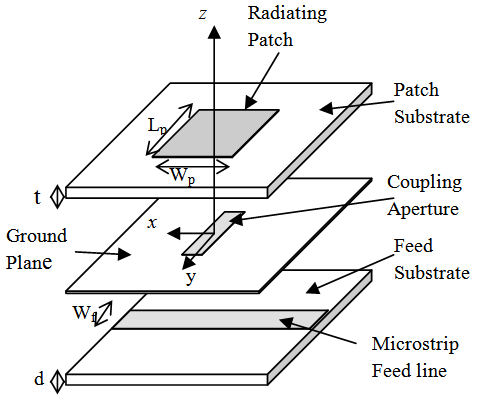Fringing Field In Microstrip Patch Antennas
Antenna-Theory.com - Transient Fields Under a Microstrip Antenna Microstrip Antenna - Transient Fields (the Movie) On this page, I will present a movie showing the fields under a microstrip antenna. In this numerical experiment, a short pulse will be launched from the end of a microstrip, which will travel towards the patch antenna. Some of the pulse will radiate away, and some of the power will be reflected back down the microstrip line. This type of simulation gives a little bit better idea of what is going on with a patch antenna, specifically when short pulses (short waveforms, or brief applied voltages) are incident upon a microstrip antenna.
Specifically, consider a patch antenna that is mounted on a ground plane, with a dielectric with equal to 2.2. The thickness of this dielectric is 0.795 mm (millimeters). The patch antenna will be 1.25 centimeters wide and 1.56 centimeters long (you should be able to tell what frequency this antenna will radiate well at - if not, see page). The microstrip antenna will feed the patch offset from the center, as shown in Figure 1. Offset feed for Patch Antenna.


Fusionfall Download Free. The transient pulse will be of the form given by exp(-(t-T0)/T )^2, where T0 is the time delay and will be 45 pS (picoseconds, 10^-12), and T is a parameter that controls the rate of rise and fall, which is 15 pS. This function is plotted in Figure 2. Incident (transient) pulse fed to a Patch Antenna. In the following video, we will view the z-directed electric field, immediately below the patch antenna. Note that the surface of the patch is normal to the z-axis.
We can clearly see the incident pulse propagate down the microstrip line, be disturbed by the microstrip antenna, then some of the fields are reflected, some radiate away, and some stay resonant below the patch and eventually radiate away or reflect back down the microstrip line. Patch Antennas A simulation of a patch antenna fields are shown; particularly a broadband Gaussian pulse on a square microstrip or patch antenna is shown. This video shows a Gaussian pulse travel down the microstrip. Some energy is reflected back. Incidentally, taking the Fourier transform of the incident pulse and the returned signal and taking the ratio would give as a function of frequency for this antenna. If you would like to see how this numerical electromagnetics simulation was developed, see the page. Buku Ajar Fisiologi Kedokteran Ganong Pdf To Excel.
It is the fringing fields that are responsible for the radiation. Note that the fringing fields near the surface of the patch antenna are both in the +y direction. Hence, the fringing E-fields on the edge of the microstrip antenna add up in phase and produce the radiation of the microstrip antenna. Microstrip patch antenna can be fed by a variety of methods (Ojha et al,2011) These. Fringing field which is a function of effective dielectric.